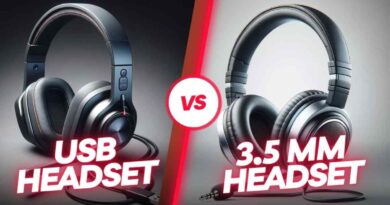DAC Vs. Amp: The Main Differences?
When it comes to enhancing your audio experience, whether you’re setting up a home theater, a professional studio, or just enjoying your favorite tunes, understanding the difference between a DAC (Digital-to-Analog Converter) and an amplifier (Amp) is crucial. In this detailed guide, I’ll walk you through the main differences between DACs and amps, how they function, and how they contribute to your audio setup.
What Are Digital-to-Analog Converters (DACs)
A DAC, or Digital-to-Analog Converter, is an essential component in the world of audio technology. It converts digital audio signals, which are composed of binary codes (0s and 1s), into analog signals that your headphones or speakers can play. Here’s a breakdown of what DACs do and why they are important:
Conversion Process: The DAC receives a digital signal from sources like your computer, smartphone, or CD player and transforms it into an analog signal. This analog signal is what you hear as sound.
Importance in Audio Quality: The quality of the DAC directly affects the sound quality. A better DAC can accurately translate digital signals into higher-quality analog sounds, leading to clearer and more detailed audio playback.
Key Takeaways:
- DACs convert digital audio signals into analog ones.
- The quality of a DAC significantly affects the overall sound quality.
What Are Amplifiers
An amplifier, often abbreviated as amp, boosts the power of audio signals, allowing them to drive speakers or headphones efficiently and effectively. Here’s what you need to know about amplifiers:
Functionality: Amps take the low-power audio signal from your playback device or DAC and amplify it, enabling the signal to be strong enough to move the drivers in speakers or headphones.
Types of Amplifiers: There are various types of amplifiers, such as tube amps, solid-state amps, and hybrid amps, each offering unique characteristics and benefits to sound production.
Key Takeaways:
- Amplifiers boost the power of audio signals.
- There are various types of amps, each affecting sound quality differently.
Technical Specifications and Differences
When comparing DACs and amps, it’s important to consider their technical specifications. This comparison can help you understand their roles and the impact they have on your audio system.
DAC Specifications:
- Resolution: Measured in bits, the resolution of a DAC indicates how accurately it can convert a digital signal into an analog signal. Higher resolution means more detailed sound.
- Sampling Rate: Measured in Hertz (Hz), this specifies how many times per second a digital audio sample is taken. Higher rates translate to better sound fidelity.
Amp Specifications:
- Power Output: Measured in watts, this indicates how much power an amp can deliver to your speakers. More power means the ability to drive larger speakers.
- Impedance: Measured in ohms, this is critical for matching the amp with speakers or headphones to ensure optimal performance and sound quality.
Role of DACs in Various Devices
DACs are embedded in many modern audio devices, but their quality can vary significantly. High-quality external DACs can provide superior sound quality compared to the built-in DACs in many devices.
Examples of Devices with DACs:
Smartphones: Most smartphones have an integrated DAC, but audiophiles often prefer external DACs for better audio quality.
Computers: External DACs can bypass the often mediocre-quality DACs found in computers, enhancing the sound quality of audio playback.
Key Takeaways:
- External DACs typically offer better sound quality than built-in DACs in devices.
- Upgrading to a high-quality DAC can significantly improve audio fidelity.
Role of Amplifiers in Audio Systems
Amplifiers are crucial for powering high-end audio systems. They ensure that audio signals are strong enough to drive even the most demanding speakers or headphones.
Examples of Amp Usage:
Home Theaters: Amps in home theaters power multiple speakers to create an immersive sound environment.
Music Production: In studios, amps are used to drive studio monitors, providing accurate sound reproduction necessary for production.
Key Takeaways:
- Amps are essential for powering complex audio setups like home theaters and studios.
- They are vital for achieving high-quality sound reproduction in demanding environments.
Compatibility and Integration
Understanding how DACs and amps work together is essential for setting up an optimal audio system. The right combination can enhance your audio experience significantly.
Integrating DACs and Amps:
Connection: Ensure your DAC and amp are properly connected, typically via RCA or XLR cables, for best results.
Synergy: Choose components that complement each other’s strengths. For example, a warm-sounding amp might pair well with a detailed DAC.
Key Takeaways:
- Proper connection and synergy between DACs and amps are crucial for optimal sound.
- Selecting compatible components can greatly enhance audio quality.
Impact on Sound Quality
The differences between DACs and amps are significant when it comes to the overall sound quality of your audio system. Each plays a distinct role in shaping the sound you hear.
DAC’s Impact:
Detail and Clarity: A high-quality DAC can bring out details in the music that you might not have noticed before.
Soundstage: Improves the perceived spatial characteristics of the sound, making it feel more live and expansive.
Amp’s Impact:
Volume and Power: An amp provides the necessary power to handle higher volumes without distortion.
Dynamics: Enhances the dynamic range of audio, making soft sounds quieter and loud sounds more impactful.
Key Takeaways:
- DACs enhance detail, clarity, and soundstage.
- Amps boost volume, power, and dynamics, improving overall sound impact.
Personal Recommendations and Conclusion
Choosing between a DAC and an amp depends on your specific needs and existing equipment. If your audio system lacks clarity or detail, investing in a high-quality DAC can make a significant difference. On the other hand, if you need to drive high-power speakers or want more volume without distortion, an amp will be more beneficial.
In my experience, a system that includes both a high-quality DAC and a powerful amp will provide the best audio experience. The DAC will ensure that the audio signal is pristine and detailed, while the amp will provide the power needed to bring that sound to life, whether through headphones or speakers.
Final Thoughts:
A combination of both a high-quality DAC and a powerful amp usually offers the best sound enhancement.
Consider your audio system’s specific needs when deciding between upgrading your DAC or amp.
Frequently Asked Questions
What is a DAC?
A DAC, or Digital-to-Analog Converter, transforms digital audio signals into analog ones, crucial for listening.
What does an amplifier do?
An amplifier boosts the power of audio signals, enabling them to drive speakers or headphones effectively.
Can I use a DAC without an amp?
Yes, you can use a DAC without an amp if your audio device has low power requirements or has an integrated amp.
Is an expensive DAC always better?
Not necessarily; the improvement depends on your audio system’s other components and quality.
What should I look for in an amp?
Look for an amp with sufficient power output and compatible impedance for your speakers or headphones.
How do DACs affect sound quality?
DACs improve the clarity, detail, and soundstage of the audio you hear.
Can any amp work with any speakers?
No, you need to match the amp’s power output and impedance with your speakers for optimal performance.
Do I need a DAC if my player already has one?
An external DAC can often provide better sound quality than the built-in DACs in many devices.
How do I connect a DAC to an amplifier?
Typically, DACs are connected to amps using RCA or XLR cables.
Should I upgrade my DAC or amp first?
Upgrade based on your system’s weakest component; if the sound lacks detail, upgrade the DAC; if it lacks power, upgrade the amp.




